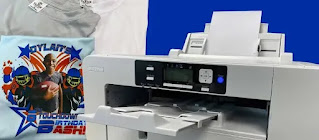What is a Dye-Sublimation Printer?
A dye-sublimation printer is a type of computer printer that uses heat to transfer dye to a medium such as a plastic card, printer paper, or poster paper. Typically, one color is laid at a time using a ribbon with color panels. Most dye-sublimation printers use CMYO colors, which differ from the more well-known CMYK colors in that the black dye is replaced with a clear overcoat. This overcoating (which goes by different names depending on the manufacturer) is essentially a thin laminate that protects the print from UV light and air discoloration while also making the print water-resistant. Many dye-sublimation printers, both consumer and professional, are designed and used to produce photographic prints.
Dye-sublimation printers, also known as dye-sub printers, are designed to print on specific surfaces such as plastic. If you need to print ID cards in color, for example, a dye-sub printer can produce a large quantity of them quickly.
What do dye-sublimation printers do?
Dye-sublimation printers are ideal for printing on non-traditional substrates. Dye-sublimation printers produce long-lasting, high-quality print results whether you manufacture clothing, print on mugs and water bottles for brand usage or retail, or need to create banners and signs.
Dye-sublimation technology embeds the ink into the printed object, eliminating the need for ink to fade, run, or smear. The thermal printer technology used in dye-sublimation printers consistently produces professional and dependable results.
Because of its longevity and durability, some photographers prefer dye-sublimation printing to inkjet printing.
What exactly is Dye Sublimation Ink?
To print on novelty items such as coasters, t-shirts, plaques, and mugs, dye sublimation ink is used, along with intense pressure and heat. This type of ink has a few key advantages:
- It lasts longer than traditional inks. The image will not wash or peel off of the printed item.
- Waterproof dye sublimation ink
- Smudging is nearly impossible due to the high heat and coating.
- The precision is astounding (given the specificity the vaporization allows over standard inkjet droplets).
What materials are suitable for dye sublimation printing?
These printers are not designed to print on standard office media such as printer paper, labels, or envelopes. They are more commonly used for printing on coffee mugs, t-shirts, and other novelty items.
Rubber, synthetic fabric, or plastic substrates are required. Cotton and other natural fabrics are not compatible with this technology. Instead of bonding with natural fibers like synthetic fibers, gaseous ink passes directly through natural textiles.
Media containing the necessary materials for dye sublimation printing include mouse pads, floor mats, coasters, flip-flops, event wristbands, bathing suits, shower curtains, and athletic apparel. Aside from these broad promotional applications, the machines can be used to create photo prints or postcards using specially coated media such as cards or paper.


